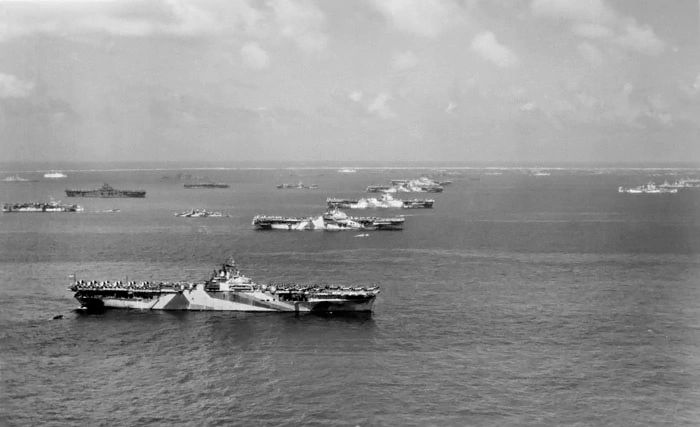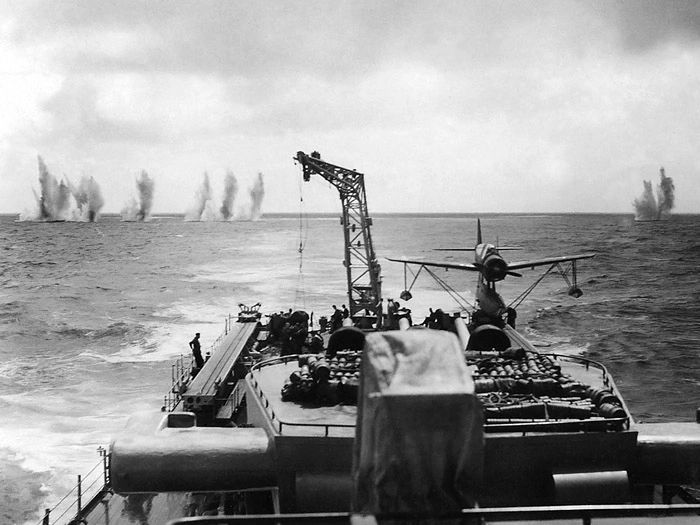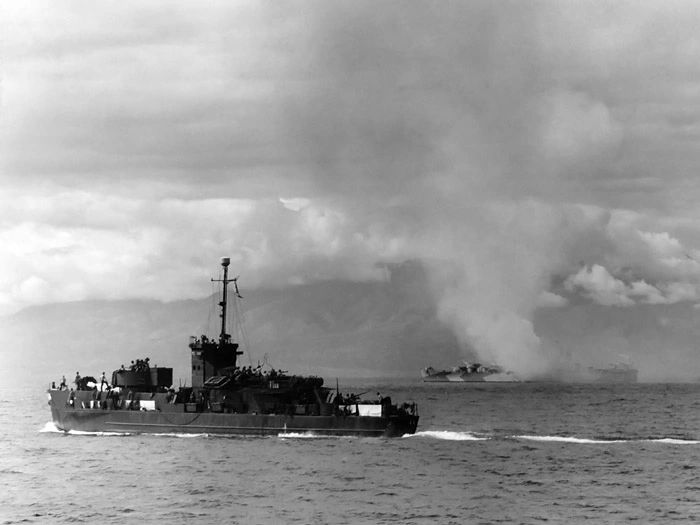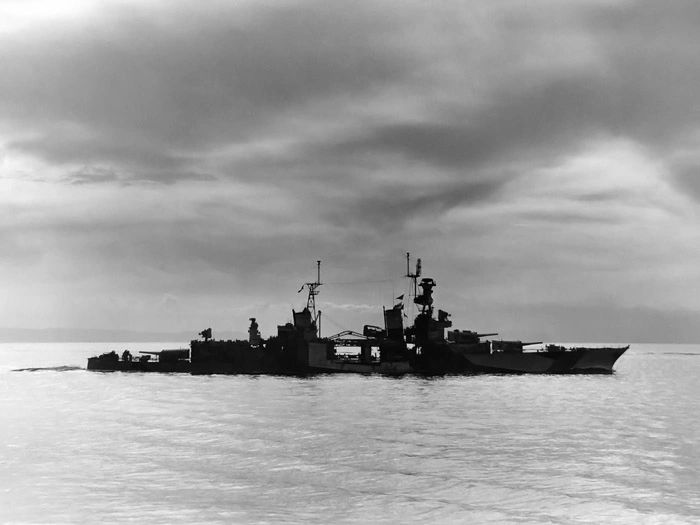MIGHTY NINETY
Chapter 9: OPERATION LOVE III

Fast carriers in the north anchorage of Ulithi Atoll on 8 December 1944. Front to back are Wasp CV-18, Yorktown CV-10, Hornet CV-12, Hancock CV-19, and Ticonderoga CV-14. At center left are Lexington CV-16 and two CVLs. This photo was taken shortly before the task force sortied for Operation LOVE III, the next phase of the Philippines Liberation.
-U.S.Navy photo in NARA record group 80-G-294129
8 December 1944
As Astoria returned to Ulithi upon the completion of training exercises, the Fast Carrier Task Force prepared to get underway for the next phase of the Philippine Liberation: the invasion of Mindoro, code-named Operation LOVE III. The island of Mindoro, just south of Luzon, was ideal for establishing airfields that could support the ultimate goal: landings on Luzon. While seaborne forces came ashore at Mindoro, aircraft from the fast carriers would play a suppression role over Japanese airfields across Luzon, preventing enemy air power from playing a role as it had at Leyte.

The American plan of attack for LOVE III. The red arrows indicate the approach of MacArthur's Mindoro invasion force on 15 December 1944. The blue arrow indicates the approach by the Fast Carrier Task Force that would take place a day earlier, positioning the carriers to provide blanketing cover over airfields across Luzon.
-manipulated from Google Earth imagery

A second photo of "Murderer's Row" taken in December 1944 at Ulithi. The carrier berthing order matches task group assignments, with TG38.1 ships in the foreground. Astoria was assigned to screen Hornet and Hancock (3rd and 4th from front, in Task Group 38.2) during Mindoro operations, along with Cabot CVL-28 (center left), Lexington (just out of picture at left) and Independence CVL-22.
-U.S.Navy photo in NARA record group 80-G-294131
11 December 1944
From Halsey's Typhoon:
At daybreak on December 11, Ulithi harbor was a whorl of activity. Gangs brought anchors to short stay and battle guidons whipped in the breeze as the ninety-odd ships of Task Force 38 steamed Indian-file at five-hundred yard intervals through Ulithi's Mugai [Channel], the only navigable passage into and out of the vast anchorage.
On either side of this nautical parade, sailors cheered from the rails of the hundreds of Third Fleet auxiliaries remaining behind... Overhead, land-based combat patrols formed a two-tiered umbrella guarding against stray bandits from Yap Island. Yet despite the "sortie fever," it was a tranquil, almost idyllic morning...
From the Mighty Ninety cruise book:
On the 11th of December we steamed out of Ulithi Atoll in company with Task Force 38 and started our first war job. We were all pretty excited because we didn’t know quite what to expect.
Task Group 38.2 Order of Battle at the outset of OPERATION LOVE III
Commander Task Group: RADM Gerald C. Bogan

Offset live fire from USS Wisconsin BB-64 splashes behind Astoria during firing practice off Ulithi on the morning of 11 December 1944. Note that one Kingfisher is airborne to spot fire.
-photos taken by and courtesy of Herman Schnipper
13 December 1944
After steaming northwest for two days, the fast carriers rendezvoused with the Logistic Support Group, Task Group 30.8, for their first underway replenishment of the operation. The oilers of TG30.8 had left Ulithi the day before the fast carriers and taken up position northeast of the Philippines. At the rendezvous point, the ships of Task Force 38 topped off with fuel oil in final preparation for their offensive operations in LOVE III.

Cleveland-class cruisers of CruDiv 14. In the foreground is Vincennes CL-64 with Miami CL-89 off her port beam.
-U.S. Navy photo in NARA record group 80-G-K-3508

USS Lexington CV-16 en route to the Philippines on 13 December 1944. Note the mast and wake of another ship visible behind Lexington. The close proximity of both ships to Astoria suggests that this photo was taken during the day's refueling operations.
-photo taken by and courtesy of Herman Schnipper
Late in the afternoon, a flight of Japanese suicide planes attacked MacArthur's invasion forces as they approached Mindoro from the Sulu Sea. The light cruiser USS Nashville CL-43 was struck amidships by a bomb-laden Kamikaze with devastating results: 131 men killed, 192 wounded. Two hours later, a second plane slammed into the destroyer Haraden DD-585. The need for air cover from the fast carriers was apparent.

USS Nashville CL-43 burns amidships from her Kamikaze hit on 13 December. The Philippine island of Negros lies in the background.
-U.S. Navy photo in NARA record group 80-G-294526
Overnight the task force began a fast run-in toward the coast of Luzon, where waves of carrier planes were launched before first light against installations and air bases across the island. Meanwhile the logistics support group maintained position east-northeast of Luzon in preparation for the return of a depleted Task Force 38 three days later.

The track chart of USS Astoria from Ulithi to Luzon. After refueling on 13 December, Halsey's Task Force began their run-in toward Luzon for strikes against Japanese airfields the following morning.
-manipulated from Google Earth imagery
14 December 1944
The Fast Carrier Task Force took up position less than 90 miles east of Luzon and launched aircraft to fly suppressive cover. The convoys of invasion craft would reach Mindoro to begin landings the next morning, and the fast carriers were determined to keep Japanese aircraft on the ground.

USS Vincennes CL-64 steams alongside Hancock CV-19 in Philippine waters circa 14 December 1944. The cruiser at upper right is USS Miami CL-89.
-U.S. Navy photo in NARA record group 80-G-431077
For the next three days, this suppression strategy worked magnificently. From Morison's Liberation of the Philippines:
Since the primary task was to blanket the airfields, no large-scale destruction resulted from the raids of 14-16 December; none had been contemplated. Out of 1671 sorties flown, 1427 were fighter planes and only 244 were bombers. Only 336 tons of bombs were dropped altogether, as compared with the 300 tons per day which had formerly been typical of Task Force 38 strikes. Nevertheless, by these raids Admirals Halsey and McCain accomplished what they set out to do. With the exception of the one Japanese strike that took off before 14 December, no Luzon-based aircraft attacked our Mindoro-bound shipping...
Additionally, not a single Japanese plane penetrated the defensive air cover put in place surrounding the Fast Carrier Task Force. The only attempt came from a flight of eleven planes that were shot down by Combat Air Patrol from two of Astoria's carriers, Hancock and Lexington. Of 270 total enemy planes destroyed, 208 of them never left the ground. In return, American aircraft losses totaled 54, half of which came from aerial combat.
McCain's response to Kamikaze tactics had worked well. So well, in fact, that Astoria had little more to do during Mindoro operations than maintain her position in formation, her crew watching while wave after wave of planes took off and landed from the carriers in her group.

F6F Hellcats fly over USS Astoria during Mindoro operations, 15 December 1944.
-photo taken by and courtesy of Herman Schnipper

American cruisers were utilized in multiple roles throughout 3rd Fleet. USS Portland CA-33 off the coast of Mindoro following her shore bombardment on 15 December 1944.
-U.S. Navy photo in NARA record group 80-G-294544

20mm gunners aboard USS Phoenix CL-46 look skyward to identify a potential Japanese aircraft off Mindoro on 15 December 1944. The ever-present tension surrounding the Kamikaze threat is apparent on the faces of men in foul weather and anti-flash gear.
-U.S. Navy Photo in NARA record group 80-G-47471

A larger crop of the same image from USS Phoenix. Thanks to the "Big Blue Blanket" of Task Force 38, no aerial threats ever materialized once carrier operations began over Luzon.
-U.S. Navy Photo in NARA record group 80-G-47471

The results of the Kamikaze attack on Nashville CL-43 from 13 December 1944. This photograph shows a similar deck area to the image above. These photos from sister Brooklyn-Class cruisers were taken within days of each other.
-U.S. Navy Photo in NARA record group 80-G-K-6886

A setting sun silhouettes USS Iowa BB-61 following the second day of air strikes over Luzon.
-photo taken by and courtesy of Herman Schnipper

USS Lexington CV-16 flanked by CVLs Cabot and Independence on 16 December 1944.
-photo taken by and courtesy of Herman Schnipper
16 December 1944
Following their third consecutive day of flight operations over Luzon, The Fast Carrier Task Force retired from the Philippines and steamed toward the next rendezvous with their oilers for refuel and resupply. Halsey's intent was to perform a quick underway replenishment and return to the Philippines, but the Pacific Ocean had other plans in store for USS ASTORIA and her task force.

USS Astoria and Task Force 38 moved away to the east of Luzon for refueling on the morning of 17 December 1944. What they did not know was that a rapidly growing Pacific typhoon was headed directly for them.
-manipulated from Google Earth imagery
Continue to CHAPTER 10: THE STORM

CLICK ON PHOTOS TO ADVANCE TO NEXT CHAPTER
BACK TO SHIP HISTORY
Sources:
Blodgett, Herbert. "Remembering Typhoon Cobra." U.S. Navy Cruiser Sailors Association Quarterly, Summer 2006, pp. 29-30.
Breuer, William B. Retaking the Philippines. New York, NY: St. Martin's Press, 1986.
Calhoun, C. Raymond. Typhoon: The Other Enemy.Annapolis, MD: Naval Institute Press, 1981.
New York, NY: Atlantic Monthly Press, 2007.

Fast carriers in the north anchorage of Ulithi Atoll on 8 December 1944. Front to back are Wasp CV-18, Yorktown CV-10, Hornet CV-12, Hancock CV-19, and Ticonderoga CV-14. At center left are Lexington CV-16 and two CVLs. This photo was taken shortly before the task force sortied for Operation LOVE III, the next phase of the Philippines Liberation.
-U.S.Navy photo in NARA record group 80-G-294129
8 December 1944
As Astoria returned to Ulithi upon the completion of training exercises, the Fast Carrier Task Force prepared to get underway for the next phase of the Philippine Liberation: the invasion of Mindoro, code-named Operation LOVE III. The island of Mindoro, just south of Luzon, was ideal for establishing airfields that could support the ultimate goal: landings on Luzon. While seaborne forces came ashore at Mindoro, aircraft from the fast carriers would play a suppression role over Japanese airfields across Luzon, preventing enemy air power from playing a role as it had at Leyte.

The American plan of attack for LOVE III. The red arrows indicate the approach of MacArthur's Mindoro invasion force on 15 December 1944. The blue arrow indicates the approach by the Fast Carrier Task Force that would take place a day earlier, positioning the carriers to provide blanketing cover over airfields across Luzon.
-manipulated from Google Earth imagery

A second photo of "Murderer's Row" taken in December 1944 at Ulithi. The carrier berthing order matches task group assignments, with TG38.1 ships in the foreground. Astoria was assigned to screen Hornet and Hancock (3rd and 4th from front, in Task Group 38.2) during Mindoro operations, along with Cabot CVL-28 (center left), Lexington (just out of picture at left) and Independence CVL-22.
-U.S.Navy photo in NARA record group 80-G-294131
11 December 1944
From Halsey's Typhoon:
At daybreak on December 11, Ulithi harbor was a whorl of activity. Gangs brought anchors to short stay and battle guidons whipped in the breeze as the ninety-odd ships of Task Force 38 steamed Indian-file at five-hundred yard intervals through Ulithi's Mugai [Channel], the only navigable passage into and out of the vast anchorage.
On either side of this nautical parade, sailors cheered from the rails of the hundreds of Third Fleet auxiliaries remaining behind... Overhead, land-based combat patrols formed a two-tiered umbrella guarding against stray bandits from Yap Island. Yet despite the "sortie fever," it was a tranquil, almost idyllic morning...
From the Mighty Ninety cruise book:
On the 11th of December we steamed out of Ulithi Atoll in company with Task Force 38 and started our first war job. We were all pretty excited because we didn’t know quite what to expect.
Task Group 38.2 Order of Battle at the outset of OPERATION LOVE III
Commander Task Group: RADM Gerald C. Bogan
| Fleet Carriers: | Hornet CV-12 | |
| Lexington CV-16 | CTG 38.2 RADM Bogan |
|
| Hancock CV-19 | CTF 38 VADM McCain |
|
| Light Carriers: | Independence CVL-22 | Night carrier unit |
| Cabot CVL-28 | ||
| Battleships: | Iowa BB-61 | |
| New Jersey BB-62 | ComThirdFlt ADM Halsey | |
| Wisconsin BB-64 | ||
| Light Cruisers: | Vincennes CL-64 | CruDiv 14 |
| Miami CL-89 | ||
| San Juan CL(AA)-54 |
||
| Pasadena CL-65 |
CruDiv 17 | |
| Astoria CL-90 | ||
| Destroyers: | DesRon 52, Desron 61 | plus Dyson DD-572 and Spence DD-512 |

Offset live fire from USS Wisconsin BB-64 splashes behind Astoria during firing practice off Ulithi on the morning of 11 December 1944. Note that one Kingfisher is airborne to spot fire.
-photos taken by and courtesy of Herman Schnipper
13 December 1944
After steaming northwest for two days, the fast carriers rendezvoused with the Logistic Support Group, Task Group 30.8, for their first underway replenishment of the operation. The oilers of TG30.8 had left Ulithi the day before the fast carriers and taken up position northeast of the Philippines. At the rendezvous point, the ships of Task Force 38 topped off with fuel oil in final preparation for their offensive operations in LOVE III.

Cleveland-class cruisers of CruDiv 14. In the foreground is Vincennes CL-64 with Miami CL-89 off her port beam.
-U.S. Navy photo in NARA record group 80-G-K-3508

USS Lexington CV-16 en route to the Philippines on 13 December 1944. Note the mast and wake of another ship visible behind Lexington. The close proximity of both ships to Astoria suggests that this photo was taken during the day's refueling operations.
-photo taken by and courtesy of Herman Schnipper
Late in the afternoon, a flight of Japanese suicide planes attacked MacArthur's invasion forces as they approached Mindoro from the Sulu Sea. The light cruiser USS Nashville CL-43 was struck amidships by a bomb-laden Kamikaze with devastating results: 131 men killed, 192 wounded. Two hours later, a second plane slammed into the destroyer Haraden DD-585. The need for air cover from the fast carriers was apparent.

USS Nashville CL-43 burns amidships from her Kamikaze hit on 13 December. The Philippine island of Negros lies in the background.
-U.S. Navy photo in NARA record group 80-G-294526
Overnight the task force began a fast run-in toward the coast of Luzon, where waves of carrier planes were launched before first light against installations and air bases across the island. Meanwhile the logistics support group maintained position east-northeast of Luzon in preparation for the return of a depleted Task Force 38 three days later.

The track chart of USS Astoria from Ulithi to Luzon. After refueling on 13 December, Halsey's Task Force began their run-in toward Luzon for strikes against Japanese airfields the following morning.
-manipulated from Google Earth imagery
14 December 1944
The Fast Carrier Task Force took up position less than 90 miles east of Luzon and launched aircraft to fly suppressive cover. The convoys of invasion craft would reach Mindoro to begin landings the next morning, and the fast carriers were determined to keep Japanese aircraft on the ground.

USS Vincennes CL-64 steams alongside Hancock CV-19 in Philippine waters circa 14 December 1944. The cruiser at upper right is USS Miami CL-89.
-U.S. Navy photo in NARA record group 80-G-431077
For the next three days, this suppression strategy worked magnificently. From Morison's Liberation of the Philippines:
Since the primary task was to blanket the airfields, no large-scale destruction resulted from the raids of 14-16 December; none had been contemplated. Out of 1671 sorties flown, 1427 were fighter planes and only 244 were bombers. Only 336 tons of bombs were dropped altogether, as compared with the 300 tons per day which had formerly been typical of Task Force 38 strikes. Nevertheless, by these raids Admirals Halsey and McCain accomplished what they set out to do. With the exception of the one Japanese strike that took off before 14 December, no Luzon-based aircraft attacked our Mindoro-bound shipping...
Additionally, not a single Japanese plane penetrated the defensive air cover put in place surrounding the Fast Carrier Task Force. The only attempt came from a flight of eleven planes that were shot down by Combat Air Patrol from two of Astoria's carriers, Hancock and Lexington. Of 270 total enemy planes destroyed, 208 of them never left the ground. In return, American aircraft losses totaled 54, half of which came from aerial combat.
McCain's response to Kamikaze tactics had worked well. So well, in fact, that Astoria had little more to do during Mindoro operations than maintain her position in formation, her crew watching while wave after wave of planes took off and landed from the carriers in her group.

F6F Hellcats fly over USS Astoria during Mindoro operations, 15 December 1944.
-photo taken by and courtesy of Herman Schnipper

American cruisers were utilized in multiple roles throughout 3rd Fleet. USS Portland CA-33 off the coast of Mindoro following her shore bombardment on 15 December 1944.
-U.S. Navy photo in NARA record group 80-G-294544

20mm gunners aboard USS Phoenix CL-46 look skyward to identify a potential Japanese aircraft off Mindoro on 15 December 1944. The ever-present tension surrounding the Kamikaze threat is apparent on the faces of men in foul weather and anti-flash gear.
-U.S. Navy Photo in NARA record group 80-G-47471

A larger crop of the same image from USS Phoenix. Thanks to the "Big Blue Blanket" of Task Force 38, no aerial threats ever materialized once carrier operations began over Luzon.
-U.S. Navy Photo in NARA record group 80-G-47471

The results of the Kamikaze attack on Nashville CL-43 from 13 December 1944. This photograph shows a similar deck area to the image above. These photos from sister Brooklyn-Class cruisers were taken within days of each other.
-U.S. Navy Photo in NARA record group 80-G-K-6886

A setting sun silhouettes USS Iowa BB-61 following the second day of air strikes over Luzon.
-photo taken by and courtesy of Herman Schnipper

USS Lexington CV-16 flanked by CVLs Cabot and Independence on 16 December 1944.
-photo taken by and courtesy of Herman Schnipper
16 December 1944
Following their third consecutive day of flight operations over Luzon, The Fast Carrier Task Force retired from the Philippines and steamed toward the next rendezvous with their oilers for refuel and resupply. Halsey's intent was to perform a quick underway replenishment and return to the Philippines, but the Pacific Ocean had other plans in store for USS ASTORIA and her task force.

USS Astoria and Task Force 38 moved away to the east of Luzon for refueling on the morning of 17 December 1944. What they did not know was that a rapidly growing Pacific typhoon was headed directly for them.
-manipulated from Google Earth imagery
Continue to CHAPTER 10: THE STORM

CLICK ON PHOTOS TO ADVANCE TO NEXT CHAPTER
BACK TO SHIP HISTORY
Sources:
Blodgett, Herbert. "Remembering Typhoon Cobra." U.S. Navy Cruiser Sailors Association Quarterly, Summer 2006, pp. 29-30.
Breuer, William B. Retaking the Philippines. New York, NY: St. Martin's Press, 1986.
Calhoun, C. Raymond. Typhoon: The Other Enemy.
MIGHTY NINETY: USS ASTORIA CL-90 cruise book. 1946.
Melton Jr., Buckner F. Sea Cobra. Guilford, CT: The Lyons Press, 2007.
Morison, Samuel Eliot. History of
Schnipper, Herman. Private photo collection.
www.archives.gov National Archives and Records Administration WWII photo archive.
www.navsource.org cruiser photo archive.
